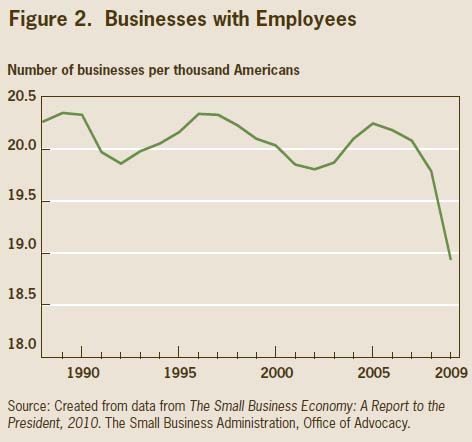| The only way to not just survive but thrive as an entrepreneurial enterprise is to destroy fixed costs and labor overhead.It is not coincidental that the middle class and small business are both in decline. Entrepreneurial enterprise and small business have long been stepping stones to middle class incomes and generational wealth, i.e. wealth that is passed down to future generations rather than consumed. As the headwinds to entrepreneurial enterprise and small business rise, the pathway to middle class prosperity narrows.
The Washington Post published a study that found U.S. businesses are being destroyed faster than they’re being created. While not exactly a surprise, it was sobering evidence that small enterprise is in structural decline: |
The U.S. economy has become less entrepreneurial over time |
| The decline of small business also hurts employment. Successful small businesses expand and hire employees. As small businesses close, jobs vanish en masse.
I have addressed this systemic decline many times, for example: The Decline of Self-Employment and Small Business (April 22, 2013) Here’s Why Small Business Isn’t Hiring, and Won’t be Hiring (July 11, 2011) |
Businesses with Employees |
What are the headwinds to entrepreneurial enterprise and small business? Here are a few key dynamics:
1. Barriers erected by cartels and the government. Cartels prosper by eliminating competition, and the easiest, cheapest way to restrict competition is to influence government to create regulatory barriers that raise the cost to levels no small business can afford. There are dozens of examples of regulations that do little to “protect the public” (the usual rationalization) whose primary intent and effect is to suppress competition.
Sickcare and higher education, to take two egregious examples, are protected from real competition: there is little real transparency in pricing and little accountability for the efficacy of the product (diplomas, wellness).
2. Overcapacity. Supply exceeds demand in almost every nook and cranny of the global economy. There aren’t many high-value opportunities to pursue because every field is already crowded or restricted.
The market ultimately sets the value of any output. You can ask $30 for a lunch plate but the market will determine the value. If your cost is $20 per plate and the market value is $15, you will lose money and go out of business.
3. High cost structure. Many people are calling for small businesses to pay their employees a living wage. I understand the emotional source of this demand: a desire to close the income gap and raise the standard of living of the working poor. But since the market sets the value of any enterprise’s output (good or services), and the business has fixed costs (rent, utilities, business licence fees, taxes, inventory, back-office overhead such as accounting, etc.), a business can only pay wages and labor overhead out of gross profit–what’s left after fixed costs are deducted from revenue.
Fixed costs and labor costs are both skyrocketing. Commercial landlords have inflated expectations of rent, thanks to the Fed-induced real estate bubble: since they overpaid for the building, they need to charge high rents to cover their mortgage payments and property taxes.
As I have explained in previous entries in this series on the middle class, the costs of labor overhead–healthcare insurance, pensions, payroll taxes, worker compensation, etc.–are rising. That leaves less available for wages.
Local governments are responding to their own soaring healthcare and pension costs by raising junk fees and taxes on small business: in many areas, a new small business faces a blizzard of fees for licenses, permits, etc.
The fundamental context of our economy is not conducive to small business or conventional employment: the cost of human labor keeps rising while technology that replaces human labor gets cheaper; fixed costs keep rising while overcapacity and anti-competitive barriers reduce high-value opportunities.
Any enterprise exposed to free-market forces must create value. If businesses can only create low value good and services, i.e. goods and services with thin margins, they can only pay low wages–not just to employees, but to the owners/entrepreneurs.
The only way to not just survive but thrive as an entrepreneurial enterprise is to destroy fixed costs and labor overhead. The food services enterprises that will thrive are those that share the expensive fixed costs of a kitchen. The enterprises that thrive will not own vehicles, they will share vehicles. The enterprises that thrive will not have employees, they will draw upon self-employed people who organize to complete a specific project/task and share the revenue.
The way to destroy fixed costs and labor overhead is to pay no business rent, own no vehicles, have no employees, owe no debt, own your own tools/means of production and nurture human and social capital. This model for small enterprise is overturning all the skimming cartels and bureaucracies: commercial real estate, local government fees and property taxes, etc. etc.
The future of middle class prosperity is entrepreneurial enterprise and joining the class of Mobile Creatives who minimize fixed costs and overhead and maximize productive cross-fertilization of skills, human and social capital and debt-free ownership (or shared access to) the means of production.
I cover all of this in my new book Get a Job, Build a Real Career and Defy a Bewildering Economy, which is in essence a how-to guide on becoming a Mobile Creative as a means of securing middle class prosperity in the emerging economy.
See more for






















